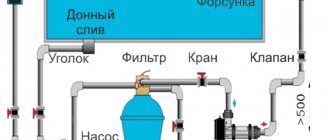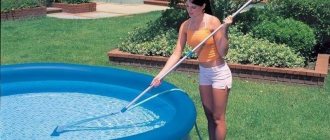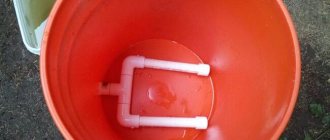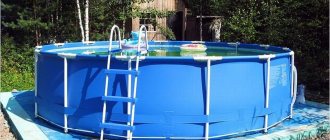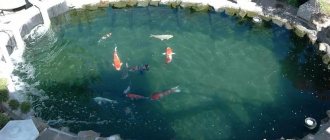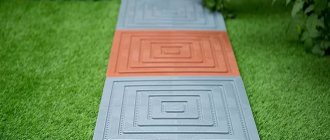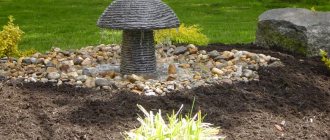Are you planning to install a PVC pool film yourself? The description of the stages of installing PVC film is quite simple and will be useful for those who want to decorate the pool with their own hands. Finishing a pool with PVC film with your own hands is a simple and short-lived task. In fact, polyvinyl chloride is a very convenient, practical and attractive material. It is perfect for finishing both a stationary and frame pool. Moreover, there is no need to wait for the glue to dry, as after laying tiles. You can immediately fill the cup with water and enjoy bathing. Let's consider laying film coverings on different types of pools separately.
PVC film for finishing a pool can be purchased for 1,000 - 1,500 rubles. (Russia). The cost of the same material with patterns from imported manufacturers will cost twice as much.
Advantages and disadvantages of such cladding
Like any other material, PVC film for swimming pools or otherwise ─ liner has its pros and cons.
Advantages:
- the commissioning period of the pool is reduced significantly due to the ease and speed of installation;
- significant reduction in the cost of the entire facility;
in appearance it is not inferior to other decorative materials;- withstands significant temperature changes;
- does not change its properties when exposed to chemicals during pool cleaning and exposure to sunlight;
- high reliability and ductility;
- ease of repair if necessary;
- reliable waterproofing qualities;
- long service life;
- low cost of coverage.
This coating also has some disadvantages:
- violation of the tightness of the coating when exposed to sharp objects or deep scratches;
- color fading over time;
- the joints are visible, which affects the overall appearance;
- if there is groundwater in the area, it is not recommended to use film;
- the difficulty of laying material in bowls with complex configurations;
- if there are steps in the pool, there is a risk of injury: the film is a slippery coating;
- difficulty in cleaning the bowl.
Restoration of the pool with PVC film
Often, a pool that has already been coated with some kind of coating needs restoration. The best quick and reliable way is to finish the pool with PVC film by hand. You just need to lay the film covering over the existing finish. The film is applied to plaster, tiles, and even a finished polyvinyl pool. This universal waterproofing product will protect the bowl from leaks and save time and money.
Advantages of film coating:
- Durability. Despite the fact that the film is inferior in its properties to, say, a tiled coating. With proper care, it can safely last up to 7 years.
- Economical. Compared to tiled flooring, it is much cheaper. You can also avoid spending money on professional installers and install it yourself. Easy to install and dismantle.
- Can be easily restored using liquid rubber or rubber patches.
- Beautiful appearance. A variety of colors and textures will satisfy every taste.
- Easy to care for. The surface of the film coating is easy to clean. Coated with an antibacterial composition, which prevents the development of microorganisms.
- Does not fade under ultraviolet light.
- Environmentally friendly material. Without harmful impurities and odor.
Disadvantages of film coating:
- Afraid of direct exposure to chemicals and sharp objects.
- Afraid of low temperatures. If the pool is outdoors, proper conservation is required.
- Restoration after conservation is possible using a repair kit.
PVC film is the most suitable option if you decide to make a budget option for a pool. It is perfect as a substitute for natural materials made of marble or stone.
Types of film coating
There are several types of films for finishing pools:
- Single layer. Polyvinyl chloride film without reinforcement is used for dismountable swimming pools; when sold, it most often comes with it.
- Multilayer. It is a sandwich of two outer layers of PVC and a Kevlar fabric layer in the middle - used for finishing stationary pools.
- Butyl rubber . A strong, wear-resistant membrane with the use of reinforcing components, which significantly increases the strength and durability of the material ─ is used for lining swimming pools, as well as in landscape design for organizing ponds and fountains.
Seam processing
To strengthen the fastening at the seams, they are additionally treated with a sealant. This is a special liquid that does not differ in color from the base material. It hardens in air. To distribute the sealant evenly, use an oiler. Work is carried out from top to bottom. Drying time is 30 minutes, but it is better to wait at least 1-2 hours to be safe.
When the PVC film is glued and the seams are processed, you can check the quality of work. Warm water (about 40 degrees) is poured into an artificial reservoir with a new coating to a height of 35-40 centimeters. The flanges are installed, and small holes are made in the film to stretch the sheets. After installing the flanges, you can completely fill the tank and begin your first swim in the updated pool! Enjoy relaxing on the shore of your own pond - the design is ready for use.
Sealing seams
How to choose a liner?
For a better appearance, several layers of acrylic are applied to the film . Impregnation with a fungicidal and antifungal composition is carried out, which protects the material from the effects of fungi and microorganisms in the water.
- Single-layer PVC film without reinforcement has a thickness of 0.65-0.8 mm and is not intended for use in winter. Widely used for frame pools in the summer. This film is inexpensive and can be easily replaced if damaged.
- Multilayer film can be with or without reinforcement. In appearance, such a film can have a matte or glossy finish, and can also be smooth or ribbed. Film with a ribbed surface is used to cover steps and small pools for children.
- Rubber . It ranks first in terms of wear resistance and reliability. It is not reinforced, but its physical characteristics are characterized by high elasticity, strength and can withstand significant temperature changes. The thickness of such a film is ─ 1.02 mm.
Description of the film
This is a synthetic fabric, the main component of which is polyvinyl chloride. It consists of two layers. The first is a reinforced base that provides mechanical strength. The second is a polymer coating that protects the walls of the pool bowl from fungus, algae and other microorganisms. PVC film has its pros and cons:
Main advantages
- Lifetime. Pools lined with film can operate smoothly for 20-25 years. Replacement of the topcoat is not required.
- Resistance to external factors. The film can withstand cyclical temperature changes and prolonged exposure to direct sunlight.
- Safety. The material does not contain components hazardous to the human body. No harmful substances are released from the surface of the film.
- High installation speed. PVC film is a lightweight material that can be laid in 5-6 hours.
- Elasticity. The polyvinyl chloride film does not tear when cracks appear on the pool bowl. It stretches, leveling out geometric changes in its size.
- Neutral. During its treatment with chemically active cleaning agents, no third-party reactions are observed.
- A variety of color and texture choices from classic blue film to extravagant mosaic finishes. There are options that imitate the finish of ceramic tiles.
- Large selection for the price. PVC films for the pool can be selected to suit any budget.
Main disadvantages
- Scratches. With prolonged use, scratches form on the surface of the PVC film pool. They cannot be repaired, you can only replace the coating.
- Tarnish. 10-15 years after laying the film, its color will fade. This is due to the action of ultraviolet rays.
- Joining seams. They cannot be completely hidden. They are visible upon careful inspection.
- Cleaning. Removing dirt and algae from the surface of a PVC film bowl requires greater physical and material costs than a similar procedure from ceramics or concrete.
- Limitation in scope. The film cannot be installed on outdoor pools with high groundwater levels.
Where can I buy it?
Film for finishing the pool can be purchased in specialized stores such as “Everything for the pool”, construction stores, and online stores. Here you can choose a film that suits all parameters: color, price, manufacturer, durability, quality.
The thickness of the film must correspond to the type of pool. For bowls up to 1 m deep, you can use a film of 0.5-0.8 mm, for the rest - 1.0-1.2 mm.
Single-layer film in our stores is most often represented by OASE (Germany) and ERGIS-EUROFILMS SA (Poland), the price varies from 230 ─ 300 rubles. m2.
Multilayer film can be purchased at prices ranging from 800 to 3,500 rubles. m2 depending on the length, width, color of the roll and manufacturer.
The following are popular among manufacturing companies:
- Elbtal (Germany),
- Alkorplan (Germany),
- Cefil (Spain),
- Aquaviva (China),
- Flagpool (European Union).
Butyl rubber film can be purchased at a cost from 800 to 4500 rubles. m2. Depending on the manufacturer and the width of the canvas. This film is presented by such companies as: Firestone (USA), Messner (Germany), Aqua-Tech (Denmark), etc.
Baths, saunas and swimming pools
0 votes
+
Vote for!
—
Vote against!
So, the pool bowl has already been filled, all that’s left is the final lining. But first you need to think carefully and wisely choose a finishing material that will give the pool maximum tightness and increase its maintenance-free service life. Today the bowl can be finished with mosaics, tiles or PVC film for swimming pools. The latter is becoming increasingly popular.
Features of PVC film for swimming pools
A synthetic film coating based on polyvinyl chloride, which is increasingly used for finishing swimming pools, simultaneously acts as a decorative cladding and a waterproofing material. PVC film, as a rule, has a reinforcing layer made of fabric with antifungal and antimicrobial impregnation. Its thickness reaches a couple of millimeters.
PVC film for pools and ponds is used by summer residents with great success, and here's why:
- PVC sheets have a long useful life, which reaches 20 years. Therefore, the film is considered a very practical material for lining pools.
- The coating is resistant to changes in temperature, cold (unlike tiles), and ultraviolet radiation.
- The film for finishing the pool bowl is absolutely safe for humans, does not emit harmful fumes, and meets all established requirements and certificates.
- The material is lightweight and quick to install, allowing you to cover the pool in a few hours.
- Polyvinyl chloride film responds well to the formation of cracks in the pool bowl.
- The film is hygienic and tolerates contact well with products intended for pool care.
- PVC film is presented on the market in a wide range of colors - from plain to material that imitates decorative tile covering, white-blue and white-beige mosaic. As a rule, it is produced in blue tones, but also comes in green, beige, turquoise and white.
- The popularity of using this material is also due to the affordable price of pool film - it is 2-3 times cheaper than mosaics or tiles.
But, along with the numerous advantages of PVC film, it is not without some disadvantages, which will be listed below:
- The main drawback is the formation of scratches on the surface of the coating, which inevitably occurs over time.
- The color intensity and gloss of the PVC film are gradually lost. Of course, this won't happen right away. But in 10 years you will notice this factor.
- The joining seams, if you look closely, still spoil the appearance of the coating.
- Cleaning a liner pool is not an easy task compared to caring for a mosaic.
- If in an area with a swimming pool the groundwater is located close to the surface, then it is better to avoid using the film.
Choosing PVC film for the pool
If you prefer PVC waterproofing film for lining your pool, then you will have to choose from the following types of material:
- Not reinforced coating. It is the cheapest, and therefore the simplest. The thickness ranges from 0.65 to 0.85 mm. No increased strength is noted. Therefore, it is recommended to use it exclusively for prefabricated pools.
- Reinforced two-layer coating. This panel is the most popular solution among summer residents who decide to build a swimming pool. The material is reinforced with polyester threads and has a thickness of one and a half millimeters. Does not deform and can withstand significant loads. Suitable for caisson and reinforced concrete pools, in which the walls are entrusted with the function of withstanding the high pressure created by water.
- Anti-slip coating. This pool film has a ribbed surface, which helps prevent slipping when swimming. This kind of material is worth laying if you are building a family pool for adults and children.
- PVC coating with acrylic. The acrylic layer acts as bactericidal protection. It is this that prevents algae, fungus and harmful microorganisms from settling in the micropores of the material, repels dirt and limescale, and is resistant to salts and chlorine. Technical characteristics (elasticity and color fastness), the service life of such a panel is approximately 2 times higher than that of a film without an acrylic coating.
PVC film has different thicknesses - from 0.5 to 1.5 mm. Choose the thickness of the material, taking into account the type of pool: for a shallow reservoir, use a panel with a thickness of 0.5-0.8, for deeper bowls - a film with a thickness of 1-1.2, for large relief pools - a thick two-layer material with a thickness of 1.5 mm . Other roll sizes are independent of thickness: the length is 25 m, and the width is 2.4 and 6.8 m.
Pool lining technology with PVC film
The film is most often installed by professionals who have special equipment, but many owners want to try their hand at this exciting activity. In the process of finishing a pool with film, you cannot do without specific knowledge, and therefore we recommend reading the following instructions.
Preparatory work
To ensure the installation of PVC film is successful, follow the tips below:
- Install the panel while maintaining the appropriate temperature conditions - at least +15°C. The film will “stick” better in hot weather.
- Stock up on an industrial hair dryer for welding PVC panels, nozzles with different jet angles that have different air flow widths, a puncher, a silicone pressure roller that is used for rolling seams, a brush with metal bristles, which is required to remove carbon deposits from the welding machine, a knife, scissors, a ruler and a high-quality solvent.
- Before starting work, put the pool in order, namely, thoroughly clean the bowl of debris and dirt.
- If you want to update an old tiled pool that has problems with waterproofing, you can lay PVC film on the tiled covering itself. However, remember that the tiles should not peel off. If in doubt about this, it is recommended to remove it and level the inner surface with PVC film before repairing the pool.
- Make sure that the surface is solid and free of potholes, bulges and cavities. If there are bulges, they should be sanded. Fill sinks and uneven surfaces with putty. This way, the film for pools under water pressure will not take on the appearance of an uneven bowl topography.
- If the above methods do not help bring the surface into proper shape, then it is worth laying a leveling layer, which is highly durable.
- The inner corner edges of the bowl must be strong. For their manufacture, use only high-quality material. If you leveled the side, then make sure that the solution fits tightly, without giving any hint of detachment from the base in the future.
Laying geotextile backing
To reduce the friction of the film on the concrete bowl and increase the useful life of the pool finishing material, you can glue a special geotextile substrate made of non-woven raw materials to the prepared and plastered surface. It also serves as a kind of insulation, making your stay in the pool more comfortable. Geotextiles are secured with screws using a metal profile using the following technology:
- First, we place the fastening strip. This is a metal tape, which, as a rule, has a length of 2 m, a width of 5-8 cm and a thickness of 2 mm. On one side there is a plastic coating on it. The film coating needs to be welded to it.
- Lay the strip closely. When attaching to the bowl, screw the screws into the pre-installed dowels. The drilling step is 10-15 cm.
- Often the bottom has a complex shape or may have steep slopes. In this case, you will have to attach strips to the bottom as well. Thus, when pouring water, you can prevent the bottom sheets from moving. At the bottom, the strip is attached at the top point of the slope.
- If the bottom of the pool is pyramidal, then do this. Lay the fastening strip along all edges adjacent to the walls. In the case of a stepped pool, the strip is laid in the same way as on the walls.
- When the pool has a concrete staircase, we use a special corner as a fastener. When installing fasteners, you need to remember that the installation of the pool film on the stairs should be done with a slight stretch.
- The most difficult procedure is to lay the fastening strip if the surface of the bowl is rounded. In this case, the work will be more labor-intensive than the curvature is less. To repeat the curved edge of a corner, make cuts by removing or inserting part of the fastener.
- Clean the pool and wash it before installing the non-woven material. The backing is fixed to the walls. To do this, it is clamped between the base of the pool and the fastening strip. Make sure the bottom end hangs down a little. Also lay the substrate loosely on the bottom. There should be no folds at the joints.
- In the most difficult cases, you can glue the sheets to the surface of the walls. Choose adhesives that have an elastic structure.
Installation of PVC film
When tiling the pool bowl, maximum care is required. Also, cut the material correctly, observe the cleanliness of the surfaces to be welded and the technology of finishing pools with PVC film:
- First you need to cut the PVC fabric. In this case, complete coverage of the pool bowl should be achieved.
- First of all, it is recommended to lay the bottom sheets, maintaining an overlap of 5-8 cm. Step back 1-2 cm from the wall. When laying the sheets, folds should not form. You need to fasten the film so that it does not move down when you fill the bowl with water. If the bottom has large slopes, let the film sit.
- After laying the film on the bottom, you can begin hanging the panels on the walls. It is customary to hang sheets plumb, maintaining overlap. For vertical seams - 5-8 cm, for wall-to-wall seams in the corner and wall-to-bottom - 15 cm.
- Pay special attention to the wall-bottom seams. It is necessary to provide for the effect of stretching the PVC sheet in the horizontal plane. Move the sheet that is attached to it a few centimeters along the bottom from the pool wall. Make more indentation, the greater the depth of the concrete bowl.
- Before welding the pool film, clean the surface of all contaminants.
- Just before welding the seam, fasten the panels to each other using the tack method, which consists of quickly and incompletely heating a small area of both PVC sheets and then compressing the tack spot. This way you can prevent the two surfaces being welded from changing position with each other. If the film sheets change their original position, folds will appear that will not disappear. Even after filling the bowl with water.
- Butt seams must be welded with hot air using special equipment. It is recommended to buy a Leister industrial hot air gun for work, which, when welding thermoplastic panels, supports the function of adjusting the temperature of the air stream.
- The strength of the weld will not be inferior to the base material in terms of strength. The big advantage is that there is no need to use glue, solvent, or other materials. The air is heated by an electric coil to a temperature of 450-600 degrees Celsius. Then it goes to the nozzles of the welding machine, ensuring fire safety and absolute environmental friendliness of the procedure.
- The air flow temperature must be adjusted depending on the ambient air temperature. Consider also the welding speed of the waterproofing film for swimming pools. Take into account the composition of the materials, whether you are welding film and film, film and fasteners together.
- Monitor voltage fluctuations in the electrical network, because the surfaces to be welded must be heated evenly, and due to voltage changes, the temperature of the air flow changes. Check the condition of the hair dryer nozzle. No carbon deposits should form on its surface. If there is one, remove it with a special metal brush.
- The film sheets in the inner corners are welded at the last stage. They bend upward along a bisector a part of the panel that is fixed vertically in a horizontal plane. In this case, it is necessary to achieve a position where the entire sheet weighs without forming folds on the surface. Bend the bend to the bottom plane, draw a line on it at a distance of 5-10 cm. It should be parallel to the bisector. Cut the film along this line and weld the inner surface of the bend.
- After the welding work has been carried out, check the quality of all seams. Check to see if any defects have formed on the surface of the PVC film pool.
- Additionally, treat the seams with a special substance for additional sealing, called seam sealer. This is a mass that is in a liquid state, hardens in the open air and remains elastic after hardening. The seal has a color similar to the color of the PVC film. When working with the seal, use a special oiler. Apply film to the joint of the sheet, having first removed any dirt from the surface. When sealing vertical seams, work downward from the top edge. After application, allow the sealant to cure for at least 30 minutes.
- To secure the film to the sides of the pool, it is customary to use a mounting profile, which looks like a corner or strip. Fix the film with a profile in places with ledges - where there are differences in height or steps. Now we can weld the film to the sides.
Filling the pool with water
When the seam seal has hardened and you have cleared the film covering of dirt and debris, you can begin filling the pool bowl with water. To achieve good results, fill the pool with water that is not too cold. Remember that the higher its temperature, the better the final result.
However, the water temperature should not be more than 40 degrees. Fill the pool half a meter to begin with, maybe even less - 30 centimeters. Then install the counter flanges of the mountings and decorative elements, lighting lanterns, only then can you add water to the level that you planned to achieve.
Now the film pool is considered completely ready for use. All that remains is to watch a video about finishing a pool with PVC film and consolidate your skills in practice. If the water is cloudy, take appropriate measures, which you will learn about in our next material.
Preparatory work
Before you begin finishing the pool, you need to do a number of preparatory work:
- The surface of the pool should be smooth; where necessary, putty and sand.
- Check the inner corners of the pool (the connection should be especially strong in this area).
- Check all embedded parts (they should not protrude from the walls, and should also be equipped with seals).
- Carefully remove debris and dirt before finishing.
- Purchase the necessary equipment for welding panels.
The air temperature should not be lower than 12-15°C.
Laying geotextile backing
Typically, finishing begins with the installation of a base covering and a fastening strip. Why is backing material so important? It will protect the film from touching the surface of an artificial reservoir.
- Lay the strip tightly. On one side you will see a plastic coating - the film will be welded to it. For fastening to the bowl, the screws are screwed into pre-installed dowels. The drilling step is from 10 to 15 centimeters.
- If the bottom has steep slopes, the strips are attached to it. When the shape is pyramidal, the strip is laid along all adjacent faces.
- Make sure that no seals are created during the fastening process. In pools with stairs, the film is secured using a fixing angle.
Pool underlay
How to decorate a bowl with your own hands?
After all the preparatory work has been completed, you can begin finishing the bowl. For a frame and concrete pool, the sequence of laying the film is different.
For a frame bowl, the sequence of work is as follows:
- remove the film from the packaging and place it on a pillow made of a special material - technoplex inside the bowl;
- collapsible elements are installed in holes sewn into the fabric;
- the sides are installed according to the design type along with the coating;
- in the case of a non-removable frame, the film is attached to the bowl with special plastic slats (attached to the frame);
- the film is leveled and the bowl is filled with water.
In the case of a concrete frame:
A thermal insulating substrate – geotextile – is laid on the bottom of the pool.- You need to start finishing from the bottom of the bowl in whole sheets and gradually go into details: corners, irregularities, steps, etc.
- The levels of the sides are controlled by a plumb line and their finishing begins from bottom to top with an overlap: on the floor - 15 cm, on the walls - 5 cm.
- All joints are sealed with a professional hairdryer and sealed again with sealant.
- The film is attached to the sides with a special plastic tape.
- The bowl is gradually filled with warm water, first 30-40 cm, so that the film stretches
- All embedded elements are cut through at the end, after laying the entire film, and secured with special flanges.
- The pool is filling completely.
Final stage
To increase the guarantee of the tightness of the welding seam, it is sealed.
The seam is treated with a special compound that hardens in air, but retains its elasticity after hardening. Time until complete hardening is 25-35 minutes. At the end of installation of the film pool, a profile in the form of an angle or strip is attached to the sides. The same element is fixed on internal irregularities - steps, ledges, niches. After this, all joints are checked and water is poured in to check the tightness. The temperature of the water in the bowl should not be higher than 45ºС.
The main types of pool film, its structure and composition
Let's start with the fact that there are now three main types of films for swimming pools, and let's get acquainted with the features of each of them.
- Option #1. We are talking here about a sealed liner, the thickness of which ranges from 0.65 to 0.8 millimeters. Ideal for collapsible pools, this film is simply hung on a previously prepared frame, after which it takes on the entire load of the bowl of water. What is typical is that all the parts of such structures can be folded, thanks to which they acquire compact dimensions. Moreover, such a film weighs a little - a maximum of 1 kilogram.
- Option number 2 . To the touch, such a film is very reminiscent of hard linoleum and is at the same time a multilayer material, the thickness of which is 1.5 millimeters. A layer of polyester fabric containing Kevlar fibers is sandwiched between two layers of polyvinyl chloride and joined to them by welding. As a result, the result is a very durable coating. This film is widely used for arranging stationary swimming pools. You can often find PVC membranes coated with acrylic or varnish; Also, the outer layer can be either glossy or embossed, that is, non-slip.
- Option number 3 . The last material used for lining the inside of swimming pools is a two-layer membrane made of butyl rubber (no reinforcement). This membrane has excellent strength characteristics and increased resistance to high/low temperatures. Typically used for the largest pool bowls, it is easy to cut and subsequently glued together during installation.
Note! Collapsible pool models are initially equipped with liner bowls. If a stationary pool is being installed, the film must be cut and then welded at the installation site.
However, there are exceptions when both coverage options are used simultaneously. We are talking about cases when the capacity of a collapsible pool is quite large. To increase the strength of the structure, the liner included in the package is first suspended, after which an additional “bag” made of a reinforced membrane is placed on top of the frame. This “bag” is welded and then secured around the perimeter using bandage tape.
Is it possible to independently determine the quality of the film?
You can determine for yourself how high quality the pool film is by making an oblique cut from its end. If it turns out that the structure is porous and loose, then the material will hardly serve you long enough. The fact is that the structure of a high-quality film should be monolithic, and the inclusions of threads should be evenly distributed.
The reverse side of the film should have the same clear relief pattern. It is also important that the coating is elastic, and you can stretch it evenly in any direction. If the material you choose meets all these requirements, then it is of really good quality.
How to make a seam of better quality?
The quality of the seam directly depends on the correct operation of the heating hair dryer. Observe a number of conditions so that you do not have to redo it:
- Maintain a clear distance between the seam being processed and the cut of the nozzle.
- The voltage supplying the electrical appliance should not change. The problem is especially acute for the private sector. But it can be easily solved by turning on the hair dryer through the stabilizer.
- We remind you once again about the need to remove carbon deposits so that the jet does not start to “play.”
- Internal corners are always processed at the end. It is possible to make minor adjustments: trim off excess, straighten strips, etc.
